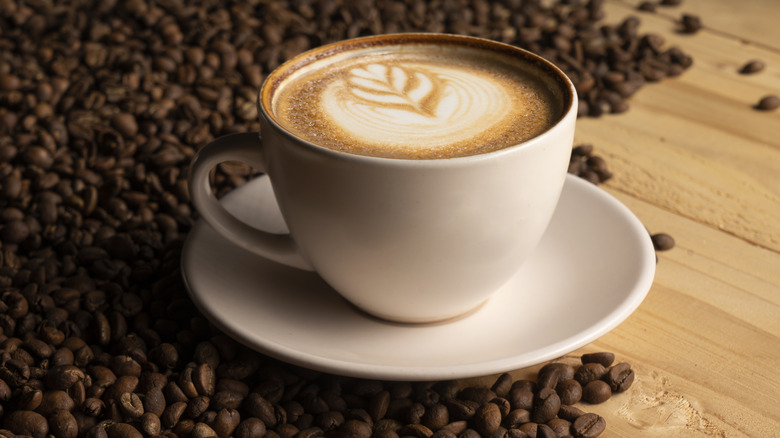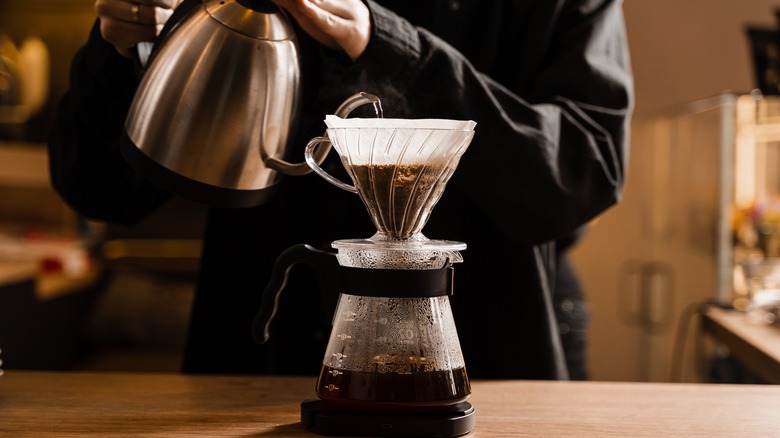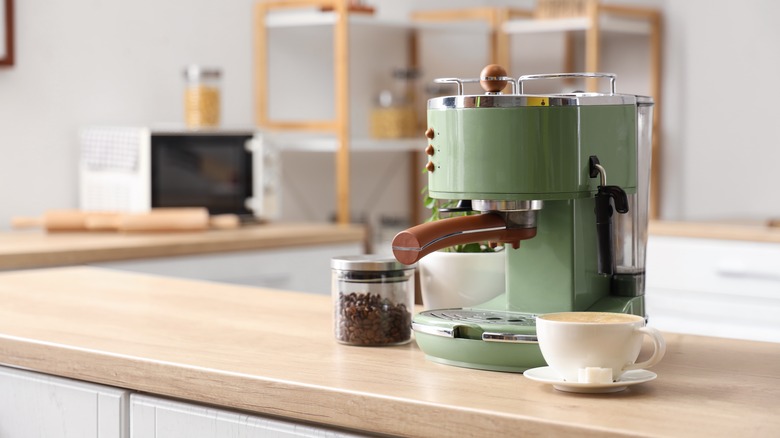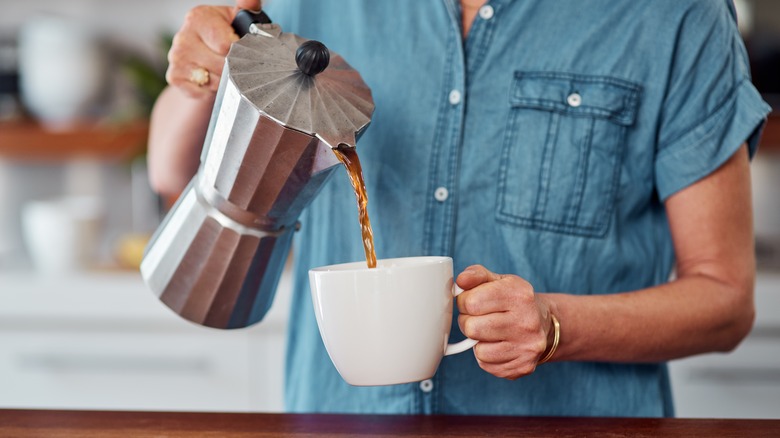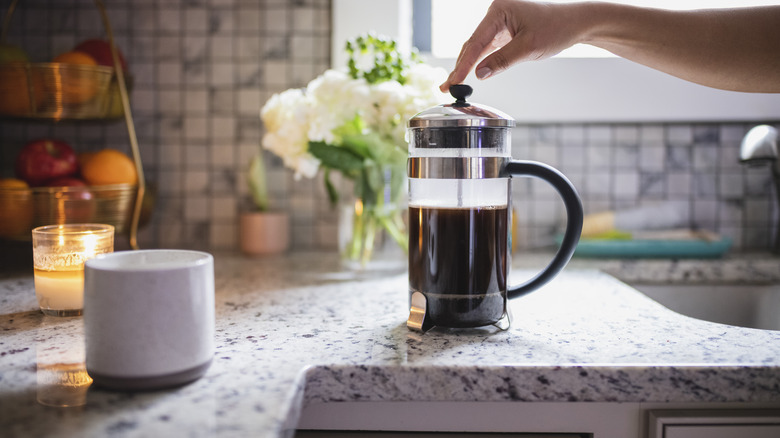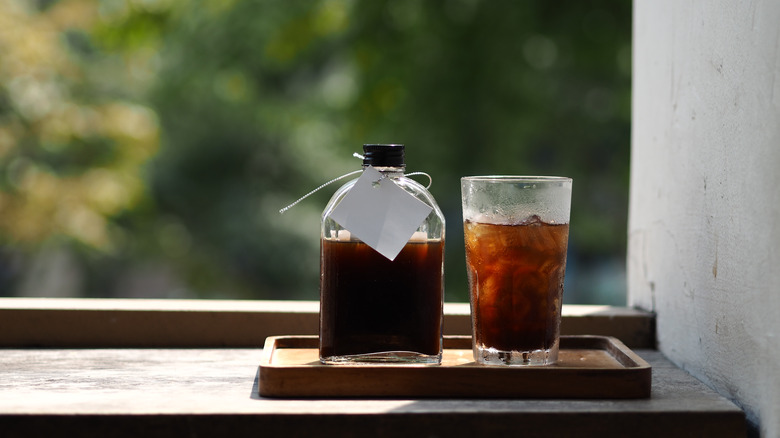The 5 Best Keurig Coffee Maker Alternatives, According To Reviews
We may receive a commission on purchases made from links.
Though they're certainly convenient for making single-serve coffees, there are many hidden downsides to Keurigs. One of the biggest is the environmental factor: The creator of Keurig actually came out and said that he regretted inventing the machine because of the amount of waste created by the disposable plastic K-cups. Coffee experts also dislike Keurig for its subpar java — the small portion of grounds in the K-cups are often watered down, and the beans are not typically fresh or high-quality. Luckily, you don't need to stick with a Keurig for your morning coffee machine — there are five alternatives with great reviews that'll give you top-notch, convenient brews.
When shopping around for a new coffee maker, you should consider a few variables. First up is cost — a typical Keurig is about $130, so if you don't want to pay much more than that, be sure to include appliances like coffee grinders in your budget breakdown. You should also think about what kind of coffee you prefer and how much milk you like. If you're a latte or Americano person, a model that makes condensed espresso is ideal. But if you prefer drip coffee (which is what you get with a Keurig), you should stick with something like a pour-over.
A pour-over coffee setup
Pour-over setups are cheap and relatively easy to use. Reviewers say that the coffee is great because you can easily control the variables, making a perfect cup to your own liking. Typically ranging from $10 to $50 on Amazon, pour-overs consist of a cone that holds a filter and fits onto a cup or other container. The contraption itself can be as simple as a small ceramic piece about the size of a coffee mug and super easy to store. You boil water, fill the cone with beans, and pour the liquid over the cone so that it drips down and creates fresh-brewed coffee.
The downsides are that you need to grind your own beans (or buy them pre-ground if you don't mind losing a bit of the freshness) and keep a regular supply of coffee filters stocked. You can remedy the latter issue by making your own sustainable reusable filter with a fabric cheesecloth, though some pour-over sets do come with metal ones. Another downside is that this method takes a bit more time and energy than a Keurig — instead of simply pressing a button, you need to bring water to a boil and complete other steps in order to obtain a fresh, steaming mug of coffee.
Simple espresso machines
Espresso machines are not as overwhelming as they may sound. We were able to find tons of options for around $100 on Amazon, and you really don't need to splurge for a fancy model in order to make great coffee. Consumer reviews claim that at-home machines like the De'Longhi (currently $86) are easy to use and make high-quality brew.
With an at-home model, you'll get concentrated espresso in just minutes, since it boils the water for you at the press of a button the same way a Keurig does. The one challenge here will be learning how to use a portafilter (it's easier than you think!) and making sure that you have a grinder that makes good coffee. The key to espresso machines is using one of the finest grind settings so that the shot is strong, and it could cost you extra to find the right one. Luckily, many models come with a grinder built inside of them or as a separate unit.
You can use any coffee beans to make espresso, so you can experiment to find your favorite brand (or save money by opting for more affordable beans). And once you have the shot, you can make tons of different drinks, from lattes to mochas to cappuccinos. Pretty much anything you'd order at your favorite coffee shop is possible with an at-home espresso machine.
Moka pots for simple espresso
If you're sold on going the espresso route due to the versatility of options but don't want to learn how to pull your own shot from a machine, you can opt for the cheap, user-friendly moka pot. These tried-and-true devices are an Italian favorite from the 1930s and helped bring the craft of making espresso out of shops and into people's homes. Moka pots create coffee that is basically like a large espresso shot: Rich and strong but not as condensed as typical espresso. For that reason, they can be a bit hard to master. However, moka pot users love the design, ease, and reliability of this machine.
To use a moka pot, unscrew the two halves and fill the bottom up with hot water from a kettle (you can also use cold water, but it may make the coffee more bitter because it'll take longer to heat). Then, grind some beans just a bit more coarse than you would for an espresso machine and fill up the basket. Piece the model back together and place it on the stove — it will heat up the water and beans and push the finished coffee into the top half of the pot so you can easily pour it and enjoy. If you need help getting the hang of it, there are plenty of YouTube tutorials that will steer you in the right direction.
A trusty French press
The French press coffee machine is another long-time favorite, allegedly invented in the 1850s when a Frenchman needed to find a way to filter out extra grounds he had added to his morning joe. This might be the simplest single-serve alternative of all, with no need for K-Cups, electric plugs, or special grinders. The end result is a nice cup of drip coffee and a device that's only somewhat hard to clean. However, this method isolates the grounds nicely, and there are plenty of genius ways to use the leftovers in your yard and garden.
To use a French press, remove the top of the device, which is also attached to the plunger and filter. Put 3 tablespoons of coffee grounds for every 1 cup of coffee you want to make, and make sure they're relatively coarse so that they don't get past the filter. Add boiling water on top and let the coffee seep, then use the plunger to slowly push down the filter. Keep it in this position as you pour out a serving of java so the grinds stay trapped at the bottom of the canister. You can also use a French press to make foamy milk for a latte or cappuccino: Just fill the device up with some warm milk and rapidly plunge it up and down to froth it.
Easy cold brew machines
If you're the kind of person who takes your coffee over ice regardless of the season, you can skip the water-boiling altogether and go straight for a cold brew. Amazon has plenty of cold brew makers that range from about $15 to $40, so it's considerably cheaper than Keurig and other electric machines. This method is also the ultimate time-saver: You don't need to do anything in the morning other than pour yourself a cup from the fridge. Cold brew customer reviews tend to boast about the amount of money the machine saves and how easy it is to use and clean.
To use a cold brew model, add coarsely-ground coffee beans to the filter that comes inside of the machine. Fill it up to your liking (you'll want to play with this level as you get to know your particular preferences) and then place it into the bottle. Pour cold water over the filter and let your coffee seep for around 12 hours at room temperature or up to 24 hours in the fridge before you pour yourself a cup. The exact recommended time varies — around 16 to 20 hours is a good range — so experiment yourself and see what gets you the best results.
